
The Supreme Court, posing for a portrait in Washington on Sept. 29, 2009
Eight months after emerging victorious from the fight over his first Supreme Court nominee, Sonia "Wise Latina" Sotomayor, President Obama is gearing up for Round 2. Party bigwigs and advocacy groups are clambering to anoint a successor to Justice John Paul Stevens, the leading liberal on the bench and a 35-year veteran of the top court, who announced last week that he will retire at the end of this term. There's already talk of potential precedents: Will Obama appoint the first Asian-American Justice? Boost the number of women on the court to a historic three? No matter whom he chooses, once his nominee is confirmed, the President will have seated as many Justices as any first-term President since Richard Nixon (who pushed through four). And we're barely into Year 2.
Quick off the blocks, Obama will still be hard-pressed to best the prolific appointers of ages past. The one to beat is George Washington — who, admittedly, had a bit of a leg up, starting the Supreme Court, as he did, from scratch. One of the first bills ever to be introduced in the Senate, the Judiciary Act, constituted a Supreme Court made up of a Chief Justice and five associates. Washington signed it on Sept. 24, 1789, and within hours he nominated six men to fill the posts. Congress responded with a haste that is unimaginable today: five nominees — John Jay (the first Chief Justice), John Rutledge, William Cushing, James Wilson and John Blair — were seated in just two days. The sixth, Robert Harrison, declined to serve, but his replacement, James Iredell, sailed through confirmation the following year. The court convened for the first time in February 1790, though the Justices wouldn't decide their first case for another two years. Washington would go on to appoint another five Justices, for a total of 10 — a record that has proved impossible to top.
Which is not to say his successors didn't try. Franklin D. Roosevelt came closest. The total number of Supreme Court Justices had changed six times since Washington's days in office, parking at nine in 1869. With his New Deal on the line, though, Roosevelt tried to make room on the bench for his supporters by claiming the right to appoint a new Justice — up to a max of 15 — whenever a sitting one turned 70 and refused to retire. His infamous "court packing" scheme never passed, but he did get all nine nominees he floated during his three terms confirmed. (By contrast, John Tyler served up nine nominations from 1844 to 1845 — and in the worst track record of any President, scored with just one.)
Tied for third are Andrew Jackson and William Taft. Old Hickory's most memorable appointment was Roger Taney, the Chief Justice who delivered the majority opinion in the infamous Dred Scott decision, which held that slaves could never be U.S. citizens. Taft has the distinction of cramming more appointments into four years in office than any other President since Washington in his first term. He got six out of six confirmed and (after losing re-election in 1912) was able to see the process from the other side: in 1921 he became the first person to serve as both President and a Supreme Court Justice. (John Quincy Adams turned down a nomination before he won the presidency in 1825.)
From there, the numbers taper off. Dwight D. Eisenhower, Ulysses S. Grant and Abraham Lincoln each had five wins; Benjamin Harrison, Warren G. Harding, Harry S. Truman and Nixon, four. All in all, U.S. Presidents have submitted 159 nominations to the court. One hundred twenty-three were confirmed, and seven declined the seat. All eyes in Washington are focused on who will be next.
